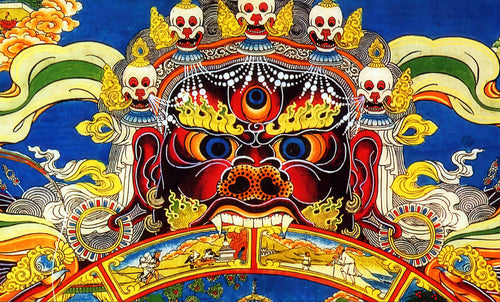
Castelot and Ballandras made gold while nobody cared
Rocco FontanaThe twenties, Nice, France... Gold! This article comes from a French review that dates from 1927, written by Andre Ibels for the Nouveau Journal de Nice At the end of the five chapters of the article you will find the protestation by a Professor of Engineering at the Conservatoire des Arts et Metiers in Paris, that accused the scientists of her time of being cowardly.
We took the article from the Adam Mc Lean website, probably the best site of alchemy ever. The article was written by Mark House, an American researcher in alchemy, who in the next issue of NitroGeno will write a commentary about this text and the experiments that took place.
How i succeeded in making gold according to the process of mr. Jollivet Castelot - December 1925
By A. Ballandras
Dosage of Gold obtained by the second method.
The residue, which had been obtained by a mixture of:
- Silver 10 grams
- Tin 3 grams
- Arsenic sulphide 3 grams
- Antimony sulphide 3 grams
was crushed as much as possible and subdued (read: subjected) to a treatment of pure chloric acid like in the first method. [Here is a reference to a first method - not presented here - the above being the second method presented by Ballandras from a text, the name and size of which is unknown to me.] However, to completely eliminate the silver and the tin employer, I scrupled to begin the indicated treatments, that is to say that the powder which was obtained having been subdued first to the action of azotic acid then washed with distillated water, then subdued to the action of chloric acid, then once more washed with distillated water, and these different operations were begun once more with another portion of pure azotic acid, and another portion of pure chloric acid after having carefully washed the insoluble residue was subdued to the prolonged action of aqua regalis following:
Chloric acid - 15 parts/ Azotic acid - 4-5 parts.
It must be noted that this thing happened during the ebullition (bubbling; boiling) The washed residue contained the slighter part of gold, this thing would be found dissolved in the last liquor, which I obtained. After 18 hours of digestion at the temperature of about 25 degrees, I subdued the mixture to ebullition during 3 hours. After refrigeration, I filtered this on wool of glass and I looked to see if parts were not drawn along in suspense. Finding nothing I proceeded with an analysis of the liquor which I obtained. For that month I made two parts strictly equal of the liquor, the first being destined to qualitative analysis, the other quantitative.
A) Qualitative Analysis: Assay of usual reagents:
- Chloride of Tin - Rose colored precipitate
- Pure Soda in solution - Voluminous yellow reddish precipitate
- Sulfate of Iron - During ebullition, metallic precipitate, greenish black very dense spangles.
B) Quantitative Analysis:
The second part of the liquor destined to undergo quantitative analysis was treated by H2S when the most important part of chloric and azotic acids were driven out by a prolonged ebullition.
This time the liquor was slightly acid and had a weak smell of chlorine. I called H2S into action; about 20 minutes long. The black precipitate which I obtained was received by a filter paper carefully washed first with well distillated water, then with hot water and at last with chloric acid. After drying in the vapor-bath, the precipitate was put in a capsule of porcelain and heated in a mould at about 850 degrees, so as to destroy the sulphides precipitated with gold i.e., the arsenic and the antimony. These were naturally decomposed by the temperature of 850 degrees to which it had been subdued during two hours. The quantity of gold obtained was 0.238 grains. The half of the liquor having served for the dissolution having been turned to good use for the qualitative analysis it followed that the whole quantity of gold contained in the original liquor should be equal to double the quantity obtained. i.e., 0.476 grains of gold per 10 grams of silver employed, yield then was 0.476 grains of gold per gram silver. {I must point out that the obtaining of gold is not a mathematical regularity, that is to say, the purport (proportion) of residue changes according to the conditions of heating.}

2) Dry method
I acted on 22 grains of chemically pure silver supplied by Messrs. Poulenc of Paris and on 3.5 grains of chemically pure orpiment supplied by the Pharmacie Central of Paris. The mixture was heated to about 1600 C in a metal smelting furnace for about ¾ hour. The residue obtained was again melted for an hour with the addition of orpiment, after having been hammered for half an hour and re-melted with the addition of small quantities of orpiment every 10 minutes, it was withdrawn. After cooling and the addition of chemically pure antimony sulphide, it was again put back into the furnace, small quantities of orpiment being thrown in every 5 minutes. The residue obtained had a dark metallic tint, after hammering it became slightly golden.
Analysis of the Residue
The residue dissolved in chemically pure 36 degree HNO3 first cold and then hot, gave an abundant pulverulent deposit. This deposit after being washed and treated with HN3 to dissolve the arsenic and antimony salts was completely dissolved in aqua regia. The liquor after being chlorinated and filtered was subjected to the reagents of Platinum and gold.
Mr. Andre Vandenberghe who was acting as preparator for this experiment, had thought that in accordance with the law of evolution of matter, the transmutation of bodies into gold should be preceded or accompanied by their transmutation into platinum. According to Mendeleiev’s progression, we have Pt - 195.2 and Au - 197.2
The reactions of gold were quite characteristic; the reactions of platinum also seemed to reveal its presence. The quantity of gold obtained in this experiment was estimated at about one gram. I emit the hypothesis that the arsenic acts as a catalyzer and the sulphur as a ferment in this transmutation.
Jollivet Castelot, Douai, December 1925
A recent experiment in transmutation
By M. Jollivet Castelot
All my research work on transmutation since 1908 has started from the fact that gold is found in nature associated with antimony and arsenic sulphides as well as with Tellurium which is considered as the mineralizer of gold. I therefore considered it logical to introduce Tellurium into the artificial combination of silver and arsenic and antimony sulphides that I make. The following is an account of one of my recent experiments:bI prepared a mixture composed of 6 grams of chemically pure silver, 1 gram of native orpiment (Arsenic trisulphide A52S3) free from gold, 1 gram of chemically pure antimony sulphide, and 2 grams of chemically pure Tellurium. I added pure silica to the usual fluxes. This mixture was heated in the furnace in the usual way for one hour at a temperature of 1100 C (approximately) [note: parenthesis are not mine AMWH].
The residue obtained was of a blackish grey color with violet reflections. It weighed 6.420 grains. When subjected to the action of nitric acid, the residue was attacked with difficulty and greenish metallic particles became detached. The solution was then decanted and a greenish-yellow residue remained which was kept at the boiling point in nitric acid for several hours, after decanting off the liquor once again, the residue, which had not changed, was washed, treated with ammonia and then subjected to the action of aqua regia in which it was entirely dissolved after boiling for several hours.
The solution after being chlorinated and then subjected to the reagents of gold, gave the following:
- Potassium Ferrocyanide - greenish brown coloration.
- Tin Protochloride + Tin Bichloride - a yellow bronze coloration and then a metallic deposit of the same shade.
- Ammonia - coloration and precipitate identical with the preceding one and which became transformed into a yellow deposit of fulminating gold at the end of a few hours.
- Formol - light yellowish black metallic precipitate.
- Peroxide of Hydrogen - light very finely divided brownish black precipitate.
- Oxalic acid - yellowish black precipitate.
- Ferrous Sulphate - golden yellow metallic precipitate.
- Caustic Potash - a fairly abundant golden yellow metallic precipitate at the end of a few hours.
The presence of gold was therefore very distinctly shown and a remarkable feature was that the metal obtained possessed the yellow bronze color of gold telluride and of native silver. I had therefore produced a bronze colored gold in my laboratory by artificial means thanks to the intervention of the Tellurium.
“A certain amount of gold was certainly lost in this test as in all my previous tests, for it is known that arsenic, antimony and Tellurium entrain gold in their fusion and their volatilization. In order to obviate this disadvantage, I had thought of making the vapors of arsenic and antimony sulphides and of Tellurium act on the silver in fusion in a closed vessel by means of a special device, but I have been forced to give up this scheme for the time being on account of the difficulties met with for the construction of this apparatus, the cost of which would be very high. I consider it certain that if the vapors were allowed to bubble through the melted silver, a much higher yield of gold would be obtained than that I have obtained hitherto by an imperfect and too rapid contact of the bodies in presence; while it is undoubtedly necessary to make them react on one another in the state of vapor in a closed vessel.” Jollivet Castelot, Douai, April 24th, 1926
The chemical manufacture of gold account of one of my last experiments in the transmutation of silver into gold
As a sequel to my previous work on the artificial synthesis of gold, I have introduced Tin into these new tests as it is also often associated with gold in nature. The following is a description of this new process, thanks to which the percentage of gold obtained destroys all the objections that are raised with regard to impurities.
I made an intimate mixture of 6 grams of chemically pure silver of which the purity was tested by a professional chemist, the Head of the laboratory of one of the most important Works of the region. 2 Grams of antimony sulphide, 1 gram of orpiment, and 1 gram of Tin; all these bodies were obtained from the Establishment Poulenc of Paris and were chemically pure. I added the usual fluxes and then heated the whole in a crucible in the furnace to about 1100 C fort2 about 1 hour, twice adding a small quantity of antimony sulphide.
The residue obtained was treated for a long period in pure 36 degree nitric acid, first cold and then at the boiling point.
The insoluble residue was next washed with distilled water, treated with ammonia, washed again and finally treated for a long period with boiling aqua regia. The liquor when filtered and subjected to the reagents of gold showed the presence of this metal in the form of deposits3 which maybe estimated at 0.05 grains in all, which is very high considering the 6 grams of silver employed.
With Oxalic acid, the solution turned violet and gave an abundant black pulverulent precipitate.
With Hydrogen Peroxide, a very finely divided precipitate of gold.
With Formic Aldehyde, a brown precipitate of gold.
With Tin Protochloride, an intense violet pink coloration.
The addition of Tin to the other bodies has certainly facilitated the reactions of the gold and increased the yield of this metal which can be manufactured artificially by my process.
It would be easy to show that, given the respective prices of gold and of the other substances that are used in my process to produce it, a profit could be obtained if the process were worked industrially; all the more so as the greater part of the silver employed can be recovered at each test.
I believe I now hold the key to the regular and even industrial manufacture of gold. But the industrial question is voluntarily put aside from my thoughts, for my only object is the search for pure scientific truth.
Jolivet Castelot, Douai, April 15th, 1927
Table of reactions
“GOLD”
- C2H2O4 - Abundant deposit of metallic gold.
- H2O2 (basic) - Brown precipitate.
- K4 Fe Cy6 . 3H2O - Green coloration.
- Na2CO3 (in ebullition) - Brownish precipitate.
- “PLATINUM & GOLD”
- NH3 - Reddish yellow precipitate (Au); topped by a yellow precipitate (Pt).
- KOH - Reddish yellow precipitate (Au); topped by a yellow precipitate (Pt).
- SnCL2.2H2O - Solution colored brown with reactions of platinum salts and deposit of black powder.
- KI - Solution becomes reddish followed by a discharge of iodine and a brown precipitate (Platinum iodide).
Extracts from the press
“It must be admitted that it is extraordinary and incomprehensible that France for the past ten years has refused to take an interest in the experiments of a rich and universally respected scientist who has given proofs of his worth, even after the conclusive experiments carried out by an official chemist, Mr Ballandras of Lyons.”
Andre Ibels, La Razon, June 8, 1927
“It is unjust, gentlemen, that a scientist of the value of Mr. Jollivet Castelot should be held in suspicion at the very moment when he is losing his sight through overwork. To continue his work, however embarrassing it may be to yours, is a sacred duty.”
Declaration by Mademoiselle M.L. of Paris. Professor of Engineering at the Conservatoire des Arts et Metiers, Paris, at the Chemical Congress in Paris. October 1927
“Oh! it is not that Mr. Jollivet Castelot has not attempted to make his invention known in France, on the contrary, he has written leaflets and books and has founded reviews for this purpose... Not only was he not taken seriously, but he was also a butt to the sarcasm and even to the insults of the official scientists in general and of the Nobelist Perrin in particular. The Acedemie des Sciences itself - as usual - refused to record his communication.”
Andre Ibels, Nouveau Journal de Nice, October 16, 1927
















































